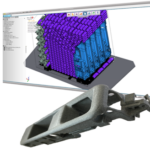Alstom, the Mannheim-based mobility company, has achieved a significant milestone with the production of 150,000 additively manufactured parts. This achievement serves as a demonstration of the growing impact of 3D printing technology on the manufacturing industry.
Alstom’s Head of Additive Manufacturing Program, Aurelian Fussel, revealed that the company has been annually producing about 40,000 parts over the last two years. This production includes a diverse range of materials, such as ceramics, polymers, and metals like aluminium, stainless steel, high-performance steel, and titanium. The applications are equally diverse, ranging from machine tools and jigs to spare parts and new designs.

Fussel highlighted the impressive variety of components, citing examples like a headlamp case for a high-speed train in France, a jig for car body shells in Germany, a soft material part for an air conditioning evacuation tube in Spain, and a steel cover for a bogie in the Nordics.
Alstom’s global presence in 3D printing is noteworthy, with hubs in various locations, housing a total of 150 machines. Fussel also hinted at upcoming advancements, mentioning the possibility of extra-large prints using robots in the coming months.
One of the key advantages emphasized by Fussel is the reduced lead time offered by additive manufacturing. With no minimum order quantities, it provides a cost-effective solution, especially for small orders. Additionally, the technology enables hard inventory reduction, contributing to the development of ‘digital warehouses’ and ‘on-demand spares.’
Looking ahead, the company envisions a future where the 3D printing market transforms into a more data-centric industry. Digital warehousing is emerging as a new business model, with a whopping 20% of train parts now printable. This shift allows for the seamless transmission of digital files globally, facilitating local manufacturing and reducing lead times significantly. Alstom’s achievement signifies a notable stride in additive manufacturing, showcasing its versatility, efficiency, and potential to reshape traditional manufacturing paradigms.
Come and let us know your thoughts on our Facebook, X, and LinkedIn pages, and don’t forget to sign up for our weekly additive manufacturing newsletter to get all the latest stories delivered right to your inbox.









